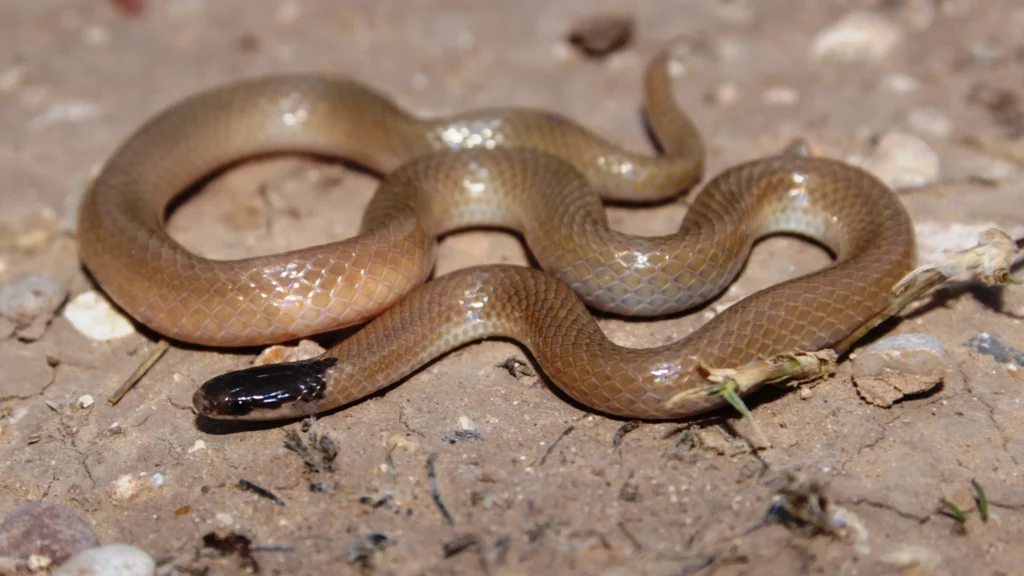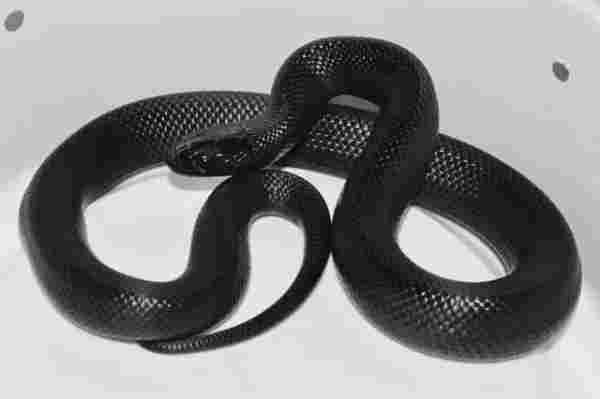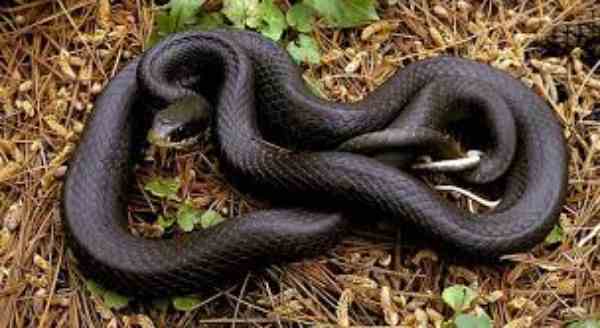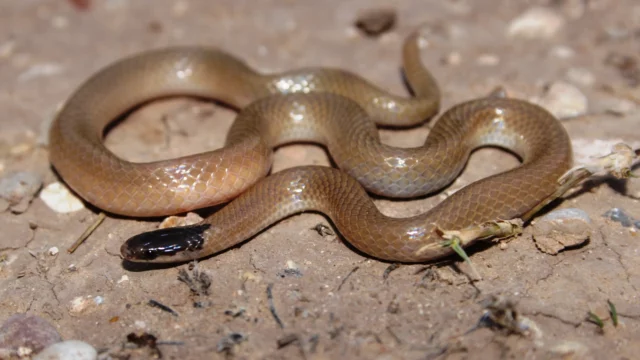Texas, a vast and diverse state known for its rich cultural heritage and stunning landscapes, is home to a fascinating array of wildlife. Among the many creatures that call the Lone Star State their home, one group of serpents stands out both for their distinctive appearance and their important ecological roles: the black snakes of Texas. These enigmatic reptiles, often shrouded in mystery and misconceptions, play a vital part in the intricate web of life that defines Texas’ ecosystems. In this exploration of black snakes in Texas, we delve into their diverse species, habitats, behaviors, and the crucial role they play in maintaining the ecological balance of this remarkable state. Join us on a journey through the shadows as we uncover the secrets of these dark and intriguing creatures that slither quietly through the heart of Texas.
8 Poisionus Black Snakes in Texas City
- Eastern Black Kingsnake
- Texas Blackhead Snake
- Mexican Black Kingsnake
- Eastern Coachwhip
- Texas Indigo Snake
- Texas Rat Snake
- Texas Glossy Snake
- Western Black-necked Garter Snake
1. Eastern Black Kingsnake (Lampropeltis nigra)

The Eastern Black Kingsnake, scientifically known as Lampropeltis nigra, is a captivating snake species found in various regions of the southeastern United States, including parts of Texas. This non-venomous serpent is renowned for its striking appearance and beneficial ecological role.
Physical Characteristics: Eastern Black Kingsnakes exhibit a predominantly black coloration, which is their most distinctive feature. This black background is adorned with bold, contrasting bands of white or yellow, which extend along the length of their bodies. The combination of black and bright bands creates a visually stunning pattern. Adults typically reach lengths between 2 to 4 feet (61 to 122 cm), making them a moderate-sized snake species.
Habitat and Range: These snakes are adaptable and can thrive in a variety of habitats, including forests, grasslands, and even urban areas. In Texas, they can be found in the eastern and southeastern regions, where their range overlaps with other snake species.
Diet and Behavior: Eastern Black Kingsnakes are constrictors and feed on a diverse diet that includes rodents, other snakes (including venomous ones), reptile eggs, birds, and amphibians. They are renowned for their ability to consume venomous snakes with impunity, thanks to their immunity to many snake venoms.
Ecological Role: These kingsnakes play a vital role in controlling rodent populations and, in some cases, even help manage venomous snake populations, making them valuable assets to the ecosystem.
Reproduction: Eastern Black Kingsnakes are known to lay eggs, and their breeding season typically occurs in the spring and early summer. Clutches can consist of up to a dozen eggs, which are typically hidden in rotting logs, leaf litter, or other concealed locations.
Conservation Status: Eastern Black Kingsnakes are not listed as endangered or threatened in their range. However, like many snake species, they face threats from habitat loss, road mortality, and persecution by humans due to misunderstandings and fear.
2. Texas Blackhead Snake (Tantilla atriceps)

The Texas Blackhead Snake, scientifically known as Tantilla atriceps, is a small and inconspicuous snake species native to parts of Texas. While it may not be as visually striking as some other snake species, the Texas Blackhead Snake possesses unique characteristics that set it apart.
Physical Characteristics: Texas Blackhead Snakes are relatively small, typically ranging from 8 to 12 inches (20 to 30 cm) in length. Their slender bodies are generally gray or brownish-black, and it’s their distinctive black head that gives them their name. This black head contrasts sharply with the lighter coloration of the rest of their body.
Habitat and Range: These snakes are found in various habitats, including grasslands, woodlands, and scrubby areas, but they tend to prefer sandy or loose soils. They are distributed across parts of Texas, including the western and central regions.
Diet and Behavior: Texas Blackhead Snakes are secretive and burrowing snakes. They primarily feed on insects, especially ants and termites, and small arthropods. Their diet reflects their preference for living in sandy or loose soils where these prey items are abundant.
Ecological Role: Although not a large predator like some other snakes, the Texas Blackhead Snake contributes to the ecosystem by helping to control insect and arthropod populations. Their burrowing behavior also aerates the soil, which can benefit other organisms in their habitat.
Reproduction: Little is known about the reproductive habits of Texas Blackhead Snakes, but like many snake species, they are believed to lay eggs. However, specific details about their reproduction and reproductive timing are still subjects of research.
Conservation Status: The Texas Blackhead Snake is not considered endangered or threatened. Nevertheless, like many snake species, they are vulnerable to habitat loss and habitat degradation due to urbanization and agriculture. Conservation efforts focused on preserving their natural habitats can help ensure their continued presence in Texas.
3. Mexican Black Kingsnake (Lampropeltis getula nigrita):

The Mexican Black Kingsnake, scientifically known as Lampropeltis getula nigrita, is a striking snake species that can occasionally be found in parts of Texas, particularly in the southwestern regions. This non-venomous serpent is admired for its distinctive appearance and its important ecological role.
Physical Characteristics: Mexican Black Kingsnakes are known for their striking and predominantly black bodies. Their black coloration is complemented by vivid white or cream-colored bands, which often run longitudinally down their backs. The contrast between the black background and the white bands creates a visually captivating pattern. These snakes are moderate-sized and can reach lengths of up to 4 feet (122 cm).
Habitat and Range: While their primary range extends beyond Texas into Mexico and other southwestern states, Mexican Black Kingsnakes are occasionally found in the southwestern parts of Texas. They inhabit a variety of environments, including deserts, grasslands, and scrublands.
Diet and Behavior: Mexican Black Kingsnakes are constrictors and have a diverse diet that includes rodents, other snakes, bird eggs, and occasionally lizards or amphibians. They are known for their ability to consume venomous snakes, including rattlesnakes, making them valuable for keeping potentially dangerous species in check.
Ecological Role: These kingsnakes play a crucial role in controlling rodent populations and, in some cases, even help manage venomous snake populations. Their ability to consume venomous snakes without harm is a testament to their remarkable adaptability and importance in the ecosystem.
Reproduction: Mexican Black Kingsnakes, like many snake species, lay eggs. Breeding typically occurs in the spring or early summer, and clutches may contain several eggs. The female will find a suitable location to deposit her eggs, such as beneath rocks or in burrows.
Conservation Status: Mexican Black Kingsnakes were not considered endangered or threatened. However, habitat loss and road mortality remain potential threats to this species, as they do for many snake species. Conservation efforts, particularly the preservation of their natural habitats, are essential to ensure their continued presence in Texas and beyond.
4. Eastern Coachwhip

The Eastern Coachwhip, scientifically known as Coluber flagellum flagellum, is a remarkable and visually distinctive snake species found in various parts of the United States, including Texas. Renowned for its striking appearance and remarkable behavior, the Eastern Coachwhip is an intriguing member of Texas’ snake fauna.
Physical Characteristics: Eastern Coachwhips are known for their distinctive appearance. They have long, slender bodies that can reach lengths of up to 8 feet (2.4 meters), making them one of the longest snake species in North America. Their coloration varies, but they are typically a uniform shade of black or dark brown. Their scales are smooth, and their head is elongated and narrow.
Habitat and Range: Eastern Coachwhips are highly adaptable and can be found in a wide range of habitats, including grasslands, woodlands, scrublands, and even urban areas. In Texas, they are distributed throughout various regions of the state.
Diet and Behavior: These snakes are diurnal, meaning they are active during the day. They are known for their exceptional speed and agility, which they use to pursue and capture prey. Their diet includes a variety of animals, such as lizards, small mammals, birds, and even other snakes. When threatened, Eastern Coachwhips can be quite defensive and may exhibit aggressive behavior, including striking.
Ecological Role: Eastern Coachwhips play a vital role in the ecosystem by helping to control populations of small mammals and reptiles. Their agility and ability to capture swift prey make them efficient hunters.
Reproduction: These snakes lay eggs, typically in early summer. Clutches can contain a dozen or more eggs, which are deposited in concealed locations such as burrows or leaf litter.
Conservation Status: Eastern Coachwhips were not considered endangered or threatened. However, like many snake species, they face habitat loss and road mortality as significant threats. Conservation efforts that focus on preserving their natural habitats and raising awareness about their ecological importance can aid in their continued survival.
5. Texas Indigo Snake

The Texas Indigo Snake, scientifically known as Drymarchon melanurus erebennus, is an impressive and highly regarded snake species native to the southern and southwestern regions of the United States, including parts of Texas. These non-venomous serpents are known for their large size, striking appearance, and important role in the ecosystems they inhabit.
Physical Characteristics: Texas Indigo Snakes are among the largest snake species in North America, with adults often reaching lengths of 6 to 8 feet (1.8 to 2.4 meters) or more. They are characterized by their long, slender bodies and glossy, smooth scales. Their coloration varies but often includes shades of dark blue-black or iridescent black, giving them their name.
Habitat and Range: These snakes are typically found in a range of habitats, including scrublands, grasslands, and desert regions, particularly in southern and southwestern Texas.
Diet and Behavior: Texas Indigo Snakes are carnivorous and primarily feed on a diet of small mammals, birds, bird eggs, and other reptiles, including venomous snakes. They are known for their powerful constricting abilities and are highly effective predators.
Ecological Role: As apex predators, Texas Indigo Snakes play a crucial role in regulating the populations of their prey species, including some potentially harmful ones like rattlesnakes. Their presence can help maintain the ecological balance within their habitats.
Reproduction: Like many snake species, Texas Indigo Snakes lay eggs. Breeding typically occurs in the spring or early summer, and clutches may contain a dozen or more eggs. The female will find a suitable location, such as burrows or other concealed sites, to deposit her eggs.
Conservation Status: Texas Indigo Snakes were not listed as endangered or threatened, but they are considered a species of concern due to habitat loss and fragmentation. Protection of their natural habitats and efforts to reduce habitat destruction are crucial for their continued survival.
6. Texas Rat Snake

The Texas Rat Snake, scientifically known as Pantherophis obsoletus lindheimeri, is a highly adaptable and commonly encountered snake species in Texas. These non-venomous serpents are known for their variable appearance, wide distribution, and important ecological roles.
Physical Characteristics: Texas Rat Snakes exhibit considerable variability in their coloration and pattern, but they often have a background color that ranges from gray to brown or yellow, with darker blotches or patterns running down their back. Their belly is typically cream or yellow. They have keeled scales, which gives them a slightly rough texture compared to smooth-scaled species.
Habitat and Range: These snakes are highly adaptable and can be found in a wide range of habitats, including forests, grasslands, agricultural areas, and even urban environments. They are distributed throughout various regions of Texas.
Diet and Behavior: Texas Rat Snakes are constrictors and have a diet that primarily consists of rodents, birds, bird eggs, and small mammals. They are excellent climbers and are often found in trees and shrubs in pursuit of prey. They are known for their calm and non-aggressive temperament when encountered by humans.
Ecological Role: As effective rodent hunters, Texas Rat Snakes play a crucial role in controlling rodent populations, which can help reduce the spread of diseases and crop damage caused by these pests.
Reproduction: These snakes lay eggs, typically in the spring or early summer. Clutches can contain a dozen or more eggs, which are usually deposited in concealed locations like rotting logs or underground burrows.
Conservation Status: Texas Rat Snakes were not listed as endangered or threatened. However, habitat loss and road mortality remain potential threats to this species. Conservation efforts aimed at preserving their natural habitats and raising awareness about their ecological importance are essential to ensure their continued presence in Texas.
7. Texas Glossy Snake

The Texas Glossy Snake, scientifically known as Arizona elegans arenicola, is a fascinating and lesser-known snake species found in parts of Texas. These snakes are characterized by their glossy appearance and are adapted to the arid regions of the southwestern United States.
Physical Characteristics: Texas Glossy Snakes have a distinctive and attractive appearance. They are typically gray or black with a glossy sheen, which gives them a polished appearance. Their bodies are slender and elongated, and they have smooth scales. They often have pale yellow or cream-colored ventral scales (belly scales) that contrast with their darker dorsal scales.
Habitat and Range: As their name suggests, Texas Glossy Snakes are adapted to arid and semi-arid environments. They are found in regions of West Texas and are known to inhabit desert landscapes, sandy flats, and rocky areas.
Diet and Behavior: These snakes are primarily nocturnal, meaning they are active during the night. Their diet includes a variety of prey items, such as lizards, small mammals, and other reptiles. They are skilled burrowers and are known to seek shelter in underground burrows or crevices during the day to escape the intense heat of their desert habitats.
Ecological Role: Texas Glossy Snakes contribute to the ecosystem by helping to control populations of small mammals and reptiles in their arid environments. They are important in maintaining the balance of species within their habitats.
Reproduction: Like many snake species, Texas Glossy Snakes lay eggs. Breeding typically occurs in the spring, and females may lay their eggs in concealed locations, such as burrows or under rocks.
Conservation Status: Texas Glossy Snakes were not listed as endangered or threatened. However, like many snake species, they face habitat loss and degradation due to urbanization and agriculture in some regions. Conservation efforts that focus on preserving their natural desert habitats are crucial for their continued survival.
8. Western Black-necked Garter Snake

The Western Black-necked Garter Snake, scientifically known as Thamnophis cyrtopsis cyrtopsis, is a snake species found in parts of the southwestern United States, including some regions of Texas. These garter snakes are characterized by their distinctive coloration and semi-aquatic habits.
Physical Characteristics: Western Black-necked Garter Snakes are relatively small, with adults typically reaching lengths of 18 to 36 inches (46 to 91 cm). They have a slender body and smooth scales. One of their most distinguishing features is a dark stripe that runs down the center of their back, which contrasts with their light-colored lateral stripes on each side. Their neck region often appears darker, giving them their common name.
Habitat and Range: These garter snakes are typically found in a variety of habitats, including wetlands, streams, rivers, ponds, and adjacent terrestrial areas. In Texas, they are distributed in the western part of the state, often in habitats with water sources.
Diet and Behavior: Western Black-necked Garter Snakes are semi-aquatic, which means they are well adapted to life near water. They have a diet that includes a variety of prey items, such as fish, amphibians, tadpoles, and aquatic insects. They are also known to feed on terrestrial prey like worms and small rodents. These snakes are generally docile and non-aggressive when encountered.
Ecological Role: As predators, these garter snakes play a significant role in controlling populations of aquatic and terrestrial prey species. They help maintain the balance of ecosystems by regulating the populations of these organisms.
Reproduction: Western Black-necked Garter Snakes are live-bearers, meaning they give birth to live young rather than laying eggs. After a gestation period, females can give birth to a small number of offspring, usually in the late spring or early summer.
Conservation Status: Western Black-necked Garter Snakes were not listed as endangered or threatened. However, like many aquatic and semi-aquatic species, they are vulnerable to habitat degradation, pollution, and habitat loss. Conservation efforts aimed at preserving their aquatic habitats are vital for their continued survival.
FAQ’S
What is the most common snake found in Texas?
The most common snake found in Texas is the Western Rat Snake, also known as the Texas Rat Snake (Pantherophis obsoletus). This non-venomous snake species is widespread throughout Texas and can be found in a wide range of habitats, including forests, grasslands, farmlands, and urban areas.
What snake bites most in Texas?
In Texas, the snake responsible for the majority of snakebites and envenomations is the Western Diamondback Rattlesnake (Crotalus atrox). This venomous pit viper is widespread throughout the state and is one of the most commonly encountered venomous snakes in Texas.

Rahul M Suresh
Visiting the Zoo can be an exciting and educational experience for all involved. As a guide, I have the privilege of helping students and visitors alike to appreciate these animals in their natural habitat as well as introducing them to the various aspects of zoo life. I provide detailed information about the individual animals and their habitats, giving visitors an opportunity to understand each one more fully and appreciate them in a more intimate way.









